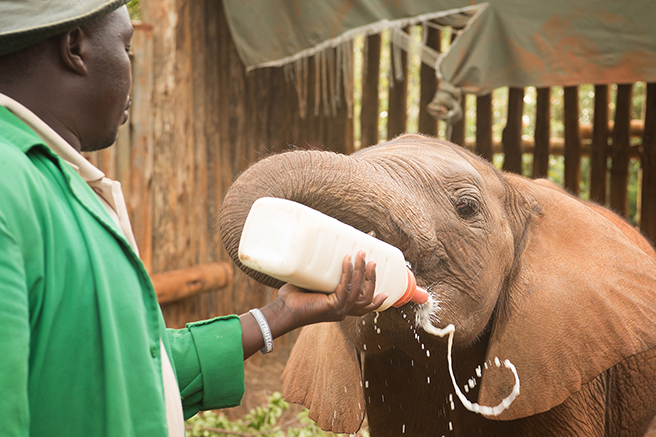They Gave Us 35 Million Years...Got 5 Minutes for Them?

“Indifferent land, red with dust
Lost gray souls flee a world unjust…”
In January of 2013 my son and I visited the David Sheldrick Wildlife Trust’s orphanage in Nairobi. His adopted elephant, a beautiful 15 month old calf named Quanza, had just arrived back in her paddock after spending the day in Nairobi National Park with 25 other orphans. Little Quanza was a recent addition at DSWT and had not yet learned to hold her own bottle. But she was animated and comfortable in her surroundings, and the affection she obviously felt for her keeper was touching and reassuring to see. That’s because the events that ultimately delivered her to the Sheldrick orphanage were a series of traumas that no living creature should ever have to endure.
Just three months earlier, on a dry plain near Amboseli and slightly north of the Tanzanian border, her mother and aunts had been slaughtered in a storm of gunfire by poachers as she stood trembling and bewildered near by. Her cousins disappeared into the dust and were never seen again. Within 48 hours the angels from DSWT were airborne to save the terrified baby. Their miracle now stood before us in the paddock, exultant and healthy. But it was impossible not to consider the reality than this animal belonged in the wild with her mother and extended family.
The orphanage is a loving sanctuary, the nearest thing to heaven an elephant baby could ever experience. But I have a dream … and that dream is to see many an empty paddock in the DSWT compound. I’d like to see the occupancy rate drastically reduced … restricted solely to those youngsters orphaned by accidents or natural causes. And that can only happen if elephant poaching becomes a thing of the past. I dream for the human realization that elephants do not exist to be destroyed for purposes of entertainment, and their body parts are not designed to serve as decoration for our homes. My friend, the great rhino conservationist Raoul du Toit, tells me that we’ll never completely eradicate poaching. I suspect he’s right, but the fight must continue on every front…in Asia where the appetite for ivory is the strongest, on patrol in the shadows of Kilimanjaro and in the courtrooms of the world.
We tend to see the poaching scourge as an issue that primarily extends on an axis between the plains of Africa and the markets of East Asia. But the problem is most certainly global, and its tentacles are embedded here in the United States as well. Even with new and more restrictive regulations in place, ivory commerce is still permitted under federal law and elephant parts are still imported to gratify the senses of trophy hunters. Considering the rate at which Africa’s elephant populations are being decimated, the time has come to ask the question: should any elephant trophies or tusks be allowed into the U.S.?
The continuing trade and transport of ivory in this country does indeed help drive the market, and it definitely impacts the lives of elephants on the African continent. The head of the U.S. Fish and Wildlife Service recently wrote, “We believe a substantial amount of elephant ivory is illegally imported and enters the domestic market. Our criminal investigations and anti-smuggling efforts have clearly shown that legal ivory trade can serve as a cover for illegal trade.“ Criticizing those who violently destroy these great animals is a fairly simple matter, but there are substantive near term actions we can take here in the United States to affect the ivory market. And the most logical and immediate of these is to shut down ivory commerce completely.
There is a petition for a 100% ban on ivory trading in the United States on the White House website as I write this. It must be signed 100,000 times by the end of this month in order to earn a place on the President’s desk. It’s incumbent on those of us who are passionate about wildlife to see that these animals receive all the protection we can give them. As of 11 May, we’re over one third of the way through the month and we still have less than 10,000 signatures. I respectfully ask that you take five minutes of your time and read, sign and share this petition.
The elephants are surely worth the few simple steps it takes to add a signature.
These iconic animals cannot speak for themselves, but the facts and numbers do. Reliable estimates place the African elephant population at between 250,000-400,000 animals. If poaching rates continue on the current trajectory (35,000 of them killed each year), they risk extinction in the wild within 10-15 years. Blood ivory is taking a keystone, ancient species to the brink of extinction.
Dame Daphne Sheldrick, founder of the orphanage now entrusted with the care of little Quanza and others like her, has stated unequivocally that ivory trade and trafficking should be universally outlawed. This petition would help realize her dream...and mine. Please join the fight by adding your name.
This piece writtern with special assistance by Lori Sirianni
Photo courtesy of Billy Dodson for The Katika Nuru Project